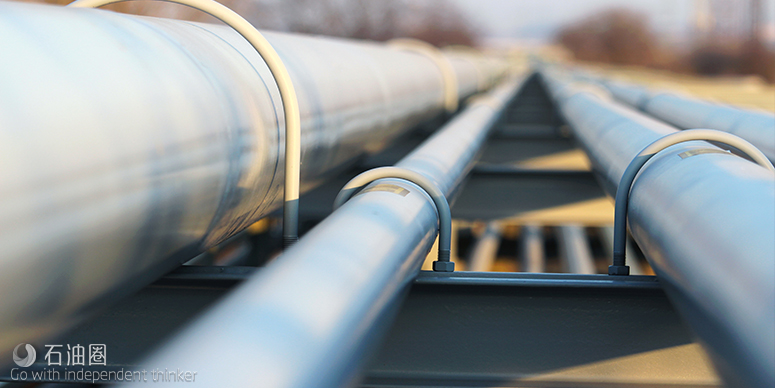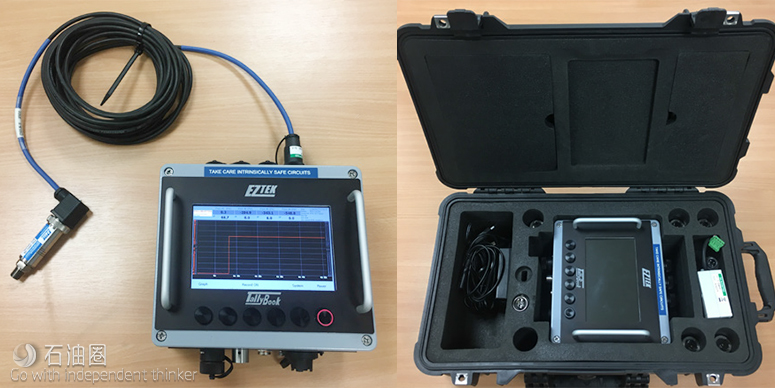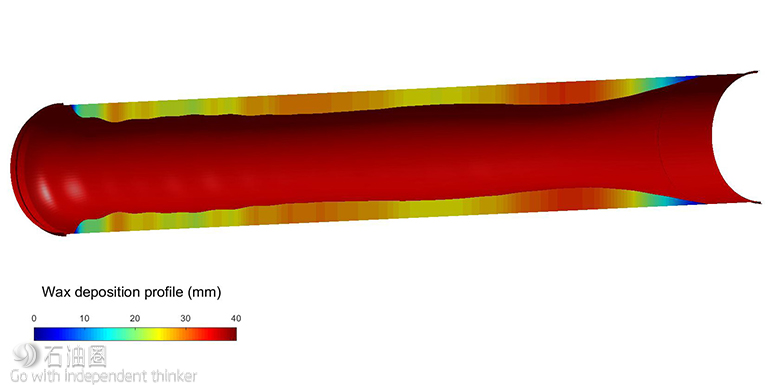The InnerVue™ Diagnostics Service is a low risk, fast and accurate technique used to detect flow inefficiencies caused by deposits such as wax or hydrates, stuck pig or tool and leaks / illegal hot-taps. A pressure wave is created at one end of the pipeline which travels at the speed of sound through the medium in the pipeline or wellbore. Without the need for intrusive intervention, the InnerVue service interprets pressure waves reflecting from changes in the internal diameter of the pipeline or wellbore and extrapolates these pressure reflections into deposit profiles or blockage and leak locations.
The InnerVue service has been successfully deployed across the world both in pipelines and wellbores to profile pipelines during pigging campaigns, locate lost inline inspection tools and verify top of cement depth, as well as many other scenarios. It allows operators to survey systems in a safe and cost-effective manner without having to stop production, risk inserting tools into the system, or investing in costly intervention campaigns.
Pipeline benefits:
Optimized planned pipeline remediation
Increased confidence in success prior to running a maintenance pig
Evaluate and track maintenance operations, such as a chemical cleaning program
Make better decisions regarding high-risk pipelines
Conduct comparative or baseline surveys during pre-commissioning
Detect an unknown pipeline feature (tee, wye)
Locate and quantify leaks
Report and recommendation on pipeline diagnosis and analysis from Halliburton experts
InnerVue™ PipeSuite Diagnostics Service
The InnerVue™ PipeSuite Diagnostics Service is a non-intrusive solution for profiling deposits and locating leaks or blockages along the length of pipelines. It can be used to baseline a pipe during pre-commissioning, to monitor the line conditions before, during and after a cleaning operation, and to diagnose leaks or blockages. The service requires pressure wave measurement equipment to be tied in directly to the pipeline system for data collection. The data collected is then analyzed using proprietary software to provide profiling of the pipe’s internal diameters or to locate leaks and blockages.
Halliburton’s advanced technology, employed in the InnerVue service, creates a pressure wave (or pulse) at one end of the pipeline, which travels at the speed of sound. This pulse returns a reflected wave that corresponds to any features detected in the pipeline, including depositions of wax, hydrate, leaks or even a stuck pig or tool, that adversely impacts flow velocity, as well as the flow medium itself (density, viscosity, etc.). A high accuracy transducer is utilized to measure pressure variations, and signals from the transducer are logged at an ultra-high sampling rate. Once the data is collected and extrapolated into profiles, Halliburton’s team of experts are available to help with diagnostic analysis and reporting to facilitate decision-making and remediation plans — without sacrificing production uptime and throughput.
The InnerVue diagnostic service can be executed with only one site technician, minimal setup and operational impact, to survey asset performance quickly and safely with a repeatable and verified high level of accuracy. The service has an acute level of accuracy when locating pipeline blockages and leaks.
InnerVue™ PipeSuite complete package of diagnostic equipment, including transit case, pressure transducers (with different ranges), data-logger, cables and charger (left) and data-logger (right).
The debris profiling mode provides a length-wise debris build-up analysis as shown in the figure below. This profile is crucial as an input for flow assurance, optimizing asset performance, lowering maintenance costs, and reducing cost and risk of physical intervention.
The debris profiling mode provides a length-wise debris build-up analysis as shown in the figure below. This profile is crucial as an input for flow assurance, optimizing asset performance, lowering maintenance costs, and reducing cost and risk of physical intervention.
Case Study 1
I An operator in South Texas was losing valuable production uptime due to an intelligent inspection tool being stuck in one of its pipelines transporting ‘supercritical’ ethylene—at a temperature and pressure above its critical point. This 6-inch ethylene pipeline system connects a 20.21-mile stretch between a Beaumont refinery and a Chevron Texaco meter site. To mitigate potential chemical hazards and minimize costly NPT, it was important to remediate the problem as soon as possible. But, before doing so, it was necessary to first determine the acoustic velocity of the pipeline contents and then survey the pipeline to locate the stuck tool.
After conducting a calibration survey of a nearby producing system carrying the same type of fluid, Halliburton’s unique InnerVue™ PipeSuite diagnostics service was implemented to determine the tool’s location within the actual pipeline. Propriety software analyzed the “pressure wave” signal response and calculated the distance to the location of the stuck tool. This solution enabled fast, accurate location of the stuck tool within 9 feet, verified by caliper data recovered from the tool, and, thus, successful retrieval.
Case Study 2
An offshore rig owned and operated by a major operator near Sakhalin Island faced a complex clean-out of their multi-phase export pipeline due to a “stuck pig” incident – just 40 days after the Berkut platform began production. This incident was caused by a build-up of hydrates and wax during the very first operational pig run.
The extreme weather conditions in the North Pacific Ocean hindered pipeline access and limited the window of time for clean-out operations. But, the deposition problem required immediate remediation, as it was slowing the transportation of crude oil, gas and condensate to an onshore terminal for processing in eastern Russia. There was also a growing threat of further wax deposit build-up from an extended period of low pressure and reduced flow rate.
To help mitigate these challenging circumstances, Halliburton provided the following services:
1.InnerVue™ PipeSuite diagnostics service to assess the deposit profile in the line
2.Laboratory analysis on production fluid and deposit samples
3.A FEED study to evaluate the different options to clean the pipeline
4.A detailed engineering study for a “progressive” pigging campaign, including pig trials performed in the UK
5.Support for the pipeline cleaning execution
Central to the proposed project plan was the pigging campaign, utilizing multi-phase production fluid along with 18 different types of pigs specifically designed for wax removal. The InnerVue PipeSuite service, which includes Halliburton’s proprietary survey technology, was executed several times – both before cleaning and in the middle of cleaning – from either side of the pipeline to profile the deposit thickness (the total volume of deposit was estimated at 577 m3). These measurements, along with results from various engineering studies conducted and chemical trials performed by Multi-Chem, a Halliburton Service (i.e., on produced oil and solid debris), helped guide the actual clean-out strategy. The following succession of pigs was driven by different medium, as well as chemical flushing with surfactant:
1.Foam pigs to prove communication
2.More aggressive foam pigs to start removing wax
3.Borefinder pigs to ensure the transition between foam pigs and bi-directional pigs
4.Bi-Directional pigs with bypass to remove wax
The project was closely monitored and managed by experienced Halliburton engineers, whose detailed pre-engineering and preparations ensured ‘right-first-time’ execution of the clean-out process. The unique combination of technology tools, procedures and oversight effectively controlled cost, resources and logistics that exceeded customer expectations and successfully restored the pipeline to full production.
Key to the project’s success was the ongoing monitoring of the pipeline remediation progress via Halliburton’s InnerVue PipeSuite service, which supported decision-making throughout the pigging campaign, by providing the confidence needed before moving to a more aggressive pig. Additionally, the mobilization of Halliburton personnel and equipment to both onshore and offshore locations enabled an effective end-to-end cleaning operation. And finally, 14 highly efficient pig runs and retrievals were made in accordance with carefully engineered procedures, including tracking methods for documenting results, before transferring operations back to the operator. This technology and approach to pipeline clean-out can be easily applied/adapted to other locations facing similar challenges.
“I would like to take this opportunity to thank you for safe and controlled execution of the InnerVue PipeSuite service project. I have had nothing but positive feedback on the work efforts of Halliburton. You have shown a high level of professionalism, commitment and proactive support to making sure it all went according to plan in the field.”
– Facilities Surveillance & Reliability Supervisor.

 石油圈
石油圈


